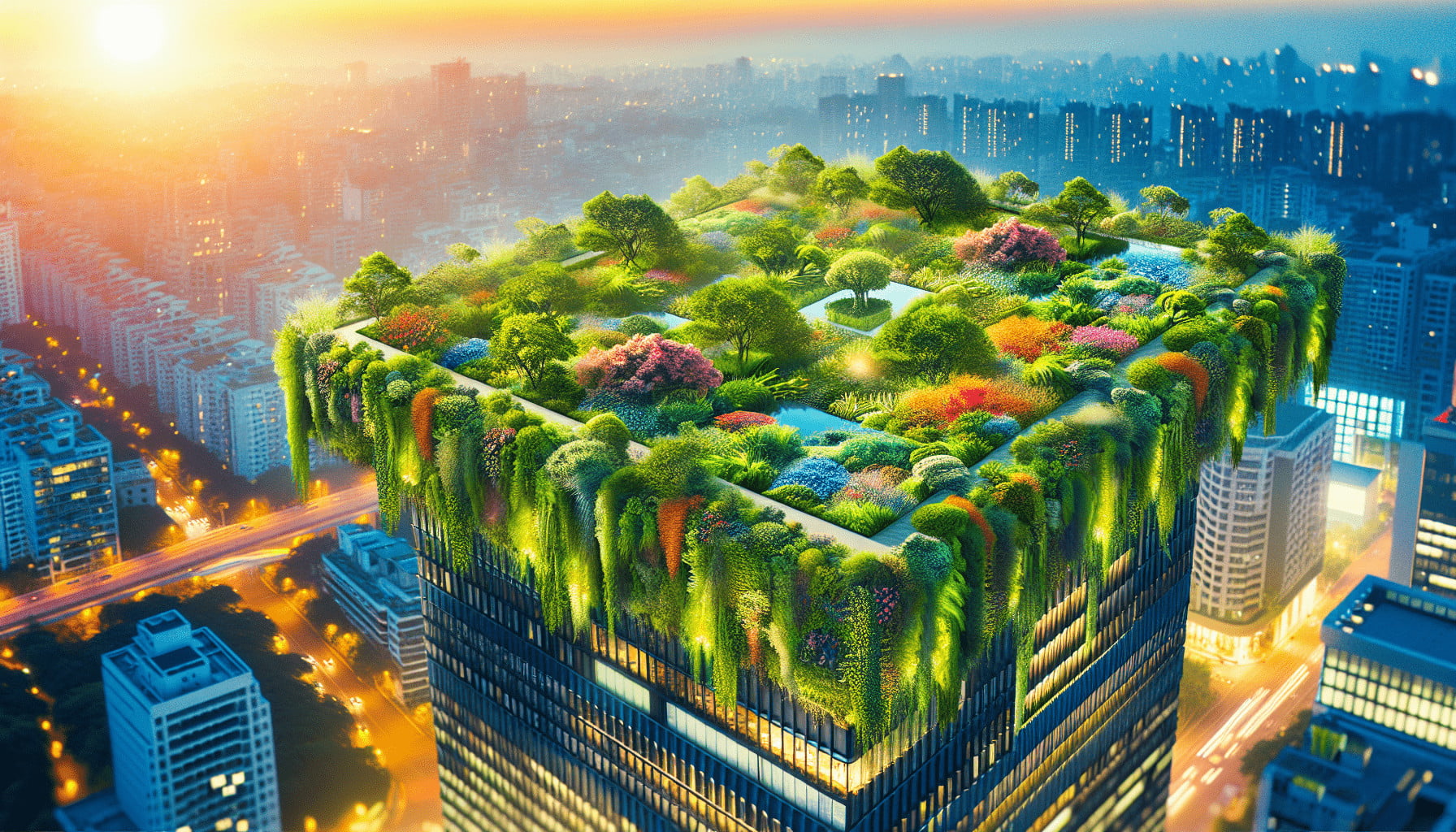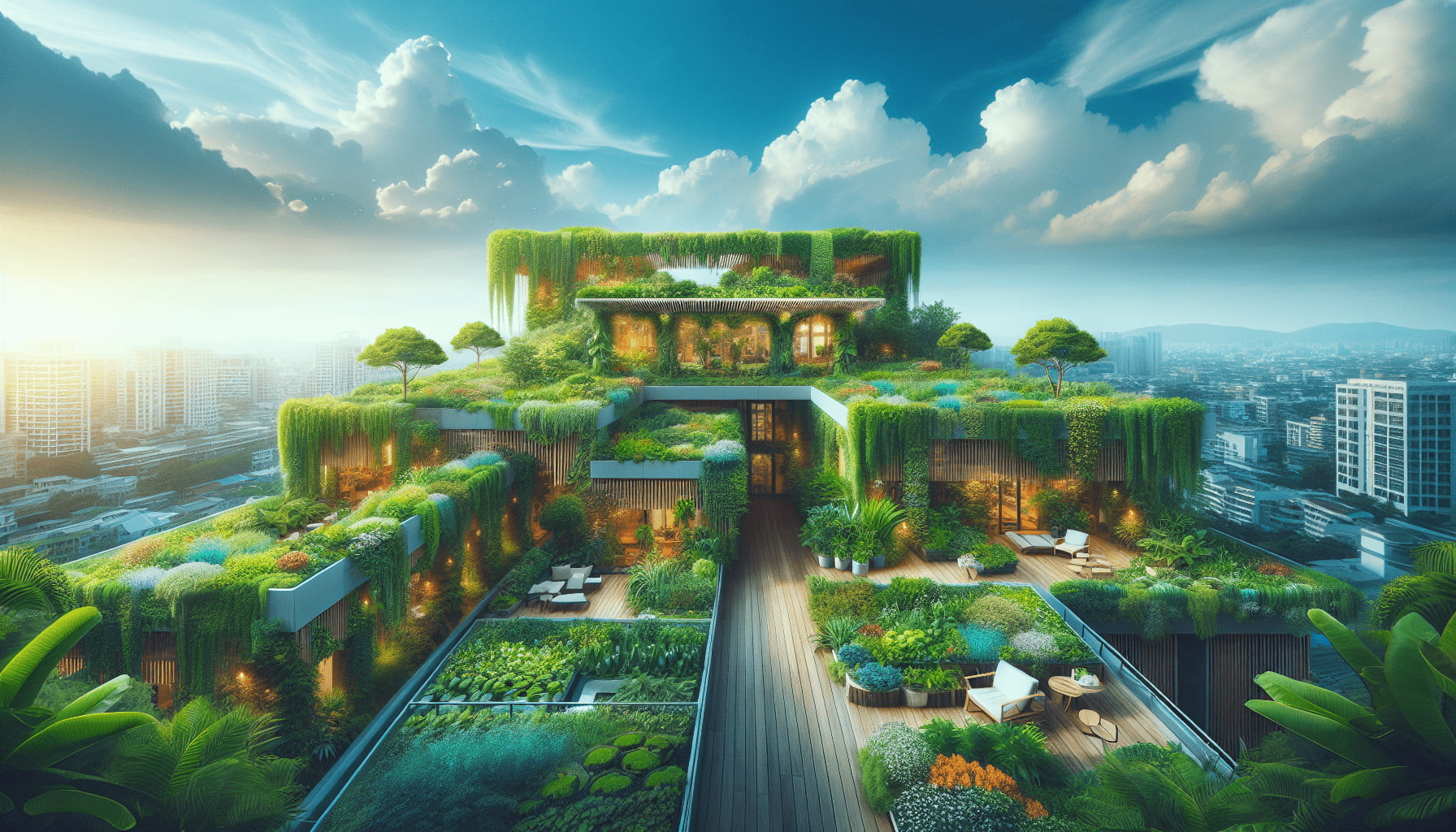Imagine walking through a bustling city, surrounded by towering buildings and busy streets. Now, picture stopping for a moment and looking up to see vibrant green roofs stretching out before you, a lush oasis amidst the concrete jungle. These green roof projects, scattered across the globe, not only provide a visually stunning sight but also serve as an inspiration for sustainable urban development. From Singapore’s Gardens by the Bay to Chicago’s City Hall, these ten examples showcase the incredible potential of green roofs in transforming our cities into greener, healthier, and more livable spaces.
1. The High Line, New York City
The High Line park
Located in the heart of Manhattan, the High Line park is a unique urban oasis that stretches over 1.45 miles. Built on an elevated railway track, it offers breathtaking views of the city skyline and the Hudson River. The park has become a popular destination for both locals and tourists, with its beautifully landscaped gardens, art installations, and various recreational activities.
Sustainability features
One of the main reasons the High Line park is considered a green roof project is its extensive use of plants and vegetation. The elevated pathway is lined with a diverse range of plant species, carefully selected to thrive in the urban environment. These plants not only provide a pleasant aesthetic but also help to absorb rainwater, reduce heat island effect, and enhance air quality.
Environmental benefits
The green roof features of the High Line park provide numerous environmental benefits. The plantings help mitigate stormwater runoff by absorbing and filtering rainwater, reducing stress on the city’s sewer system. Additionally, the vegetation acts as natural insulation, helping to reduce energy consumption in nearby buildings. The park also serves as a habitat for various bird species and beneficial insects, contributing to overall biodiversity in the area.
2. Gardens by the Bay, Singapore
The Supertree Grove
Gardens by the Bay in Singapore is renowned for its iconic Supertree Grove, a collection of towering man-made trees. These Supertrees not only provide a striking visual display but also serve important ecological functions. The towering structures are embedded with photovoltaic cells, harvesting solar energy to power the lights that illuminate them at night.
Cloud Forest Dome
Another standout feature of Gardens by the Bay is the Cloud Forest Dome, a majestic glass greenhouse that simulates a mountainous environment. The dome is home to a variety of rare and exotic plants and showcases the importance of conserving tropical biodiversity. It incorporates sustainable design and features advanced technology for maintaining optimal temperature and humidity levels.
Green Roof on the Conservatories
The green roof on the conservatories at Gardens by the Bay is a prime example of integrating sustainable architecture with lush greenery. The roof is covered with lush vegetation, providing thermal insulation to the buildings and reducing energy consumption for cooling. The green roof also helps to manage stormwater runoff by absorbing and retaining rainwater, minimizing the strain on drainage systems.

3. The Vertical Forest, Milan
Design concept
The Vertical Forest, located in Milan, Italy, is a pioneering green roof project that showcases the integration of nature and urban development. The concept behind this innovative architectural design is to create a vertical forest, where each floor of the building is adorned with trees, plants, and shrubs. The aim is to maximize biodiversity and create an urban ecosystem within the building’s structure.
Energy efficiency
In addition to its aesthetic appeal, the Vertical Forest is designed with energy efficiency in mind. The extensive vegetation on the building’s facade provides shade, reducing the need for air conditioning during hot summer months. The trees and plants also act as natural buffers against noise pollution, contributing to a more pleasant living environment.
Air purification
One of the key benefits of the Vertical Forest is its ability to purify the surrounding air. The vegetation helps to absorb carbon dioxide and other pollutants, releasing oxygen into the atmosphere. This not only improves air quality but also plays a crucial role in mitigating the effects of climate change. The Vertical Forest serves as a valuable model for incorporating green spaces into urban environments.
4. The Solaire, New York City
LEED-certified building
The Solaire, located in New York City, is an impressive example of sustainable urban architecture. It was the first residential high-rise building in the United States to receive the prestigious LEED (Leadership in Energy and Environmental Design) certification. This recognition is a testament to the building’s commitment to energy efficiency, sustainable materials, and indoor environmental quality.
Solar panels
One of the defining features of the Solaire is its extensive use of solar panels. These panels are strategically placed on the building’s roof and facades, harnessing solar energy to generate electricity. The use of renewable energy significantly reduces the building’s carbon footprint and dependence on traditional power sources.
Stormwater management
The Solaire also incorporates innovative stormwater management techniques to minimize the impact of runoff on the surrounding environment. The building features a green roof and permeable pavement, allowing rainwater to be absorbed, filtered, and stored for later use. This reduces the burden on the city’s stormwater system and helps to mitigate the risk of flooding.

5. Bosco Verticale, Milan
Vertical forest concept
Inspired by the success of the Vertical Forest in Milan, the Bosco Verticale is another magnificent green roof project in the city. Comprising two towers covered in vegetation, the Bosco Verticale aims to create a harmonious balance between urban living and nature. The towers are home to over 900 trees and 20,000 plants, which together create a lush and vibrant green facade.
Biodiversity and microclimate
The Bosco Verticale contributes to increased biodiversity within the city by providing a habitat for birds, insects, and other small animals. The dense vegetation also helps to create a microclimate within the towers, shielding residents from noise pollution, dust, and extreme temperature fluctuations. The design promotes a healthier and more sustainable urban environment.
Air purification
Similar to the Vertical Forest, the Bosco Verticale utilizes its extensive plantings to improve air quality. The trees and plants help to absorb pollutants and release oxygen, creating a healthier living environment for residents and contributing to the overall well-being of the city.
6. The Pasona O2, Tokyo
Urban farm
The Pasona O2 building in Tokyo goes beyond traditional green roof projects by incorporating an urban farm within its premises. An entire floor is dedicated to cultivating a wide range of fruits, vegetables, and herbs. This innovative approach to urban agriculture not only provides fresh produce but also educates visitors about sustainable farming practices.
Underground rice paddy
A unique feature of the Pasona O2 building is its underground rice paddy. This experimental farming method demonstrates how crops can be grown in limited space by utilizing innovative techniques. The rice paddy serves as a captivating display of sustainable agriculture and also contributes to the building’s overall sustainability goals.
Employee engagement
The Pasona O2 building promotes employee engagement by involving staff in the cultivation and maintenance of the urban farm. Employees have the opportunity to participate in farming activities, gaining a deeper understanding of sustainable agriculture and developing a stronger connection with nature. This engagement fosters a sense of community and environmental consciousness within the workplace.
7. Caixa Forum, Madrid
Vertical garden
Caixa Forum in Madrid boasts an impressive vertical garden covering an entire facade of its building. The garden is composed of over 15,000 plants, creating a stunning visual display and promoting biodiversity in the heart of the city. The vertical garden serves as a living artwork, showcasing the beauty of nature within an urban environment.
Thermal insulation
In addition to its aesthetic appeal, the vertical garden provides valuable thermal insulation to the building. The layer of vegetation acts as a barrier against heat, helping to regulate indoor temperatures and reduce the need for excessive air conditioning. This energy-efficient design contributes to cost savings and environmental sustainability.
Energy efficiency
Caixa Forum incorporates various energy-efficient features, including solar panels and a rainwater harvesting system. The solar panels generate renewable energy to power the building’s operations, while the rainwater harvesting system collects and stores rainwater for irrigation purposes. These initiatives significantly reduce the building’s carbon footprint and reliance on external resources.
8. The Wave, Vejle
Apartment complex with green roofs
The Wave in Vejle, Denmark, is an innovative apartment complex that seamlessly integrates green roofs into its design. The roofs of the buildings are covered with lush vegetation, providing numerous environmental benefits and enhancing the aesthetic appeal of the development. The green roofs contribute to improved insulation, stormwater management, and reduced energy consumption.
Stormwater management
One of the key sustainability features of The Wave is its advanced stormwater management system. The green roofs help absorb and retain rainwater, reducing the strain on drainage systems and minimizing the risk of flooding. The development’s commitment to responsible stormwater management sets an example for other urban developments to follow.
Eco-friendly initiatives
The Wave implements various eco-friendly initiatives, such as energy-efficient lighting, low-flow water fixtures, and waste recycling programs. These measures contribute to reduced energy consumption, water conservation, and waste reduction, making The Wave a model for sustainable living in urban areas.
9. The California Academy of Sciences, San Francisco
Living roof with native plants
The California Academy of Sciences in San Francisco features a living roof covered with over 1.7 million native plants. The roof serves as a natural habitat for local wildlife and also acts as an insulating layer, reducing energy needs for heating and cooling. The living roof showcases the importance of using native plants in green roof projects to maximize environmental benefits.
Solar panels
The California Academy of Sciences is equipped with one of the largest solar panel installations on a museum or aquarium in the world. The solar panels generate clean, renewable energy, significantly reducing the building’s carbon emissions. The integration of solar technology demonstrates the academy’s commitment to sustainability and renewable energy sources.
Rainwater harvesting
To further enhance its sustainable practices, the California Academy of Sciences incorporates rainwater harvesting systems. Rainwater is collected, treated, and reused for non-potable purposes, such as irrigation and toilet flushing. This innovative approach to water conservation helps reduce the academy’s reliance on municipal water sources.
10. Nanyang Technological University, Singapore
Green roof research and innovation
Nanyang Technological University in Singapore is dedicated to advancing research and innovation in green roofs. The university has established a Green Roof Centre, conducting studies and experiments to optimize the benefits and functionality of green roofs. Through ongoing research, the university contributes to the development of sustainable and environmentally friendly urban design.
Water retention and cooling effects
Green roofs at Nanyang Technological University play a critical role in water retention and cooling within the campus. The vegetation on the roofs absorbs rainwater, reducing runoff and enabling efficient water management. Additionally, the green roofs help to lower the ambient temperature, providing a comfortable microclimate and reducing the need for excessive air conditioning.
Biodiversity enhancement
The green roofs at Nanyang Technological University serve as thriving biodiverse habitats. The diverse plant species attract pollinators, birds, and beneficial insects, contributing to enhanced biodiversity on campus. The university’s commitment to biodiversity conservation aligns with its goal of creating a sustainable and nature-friendly environment.
